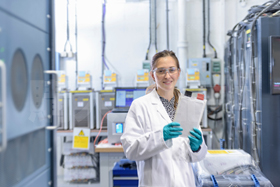
An electrode stacking device is used to manufacture the electrodes of secondary batteries. It cuts electrode materials, which have been pressed with roll press equipment, into specific lengths and alternately stacks the positive electrode, negative electrode and separator in layers.
We provide devices that stack them with high precision and at a high speed.
We enable a high production speed with our handling technologies cultivated in a variety of fields.
We can also make suggestions in accordance with customer requests, including ones on stacking method and size.
High-speed stacking is enabled by operations synchronized with the servo motor* drive.
The devices come with a function for correcting the electrode position (image processing, XYθ stage).
Position measurement and correction are made based on images, which means that the electrode does not touch the end face after it is positioned. This enables the prevention of damage to the coated object as well as the adhesion and mixture of foreign substances and impurities.
The movements for external winding of the separator are independent. This reduces the time during which stacking stops.
The structure has made each unit more accessible compared to the conventional planar structure, enabling the reduction of maintenance time.
The device can be used for batteries of various sizes by replacing the attachment of each unit and changing the control data settings.